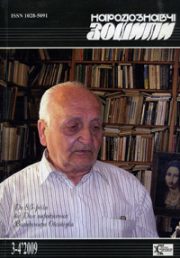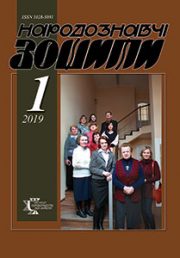The Ethnology Notebooks. 2020. № 5 (155), 1144—1157
UDK 75.036(477.87-25)”1960″
DOI https://doi.org/10.15407/nz2020.05.1144
MATKOVSKA Ivanna
- Postgraduate student of the Lviv National Academy of Arts,
- 38, Kubiiovycha Street, 79011, Lviv, Ukraine,
- Contacts: e-mail: ivanna_novakivska@ukr.net
Abstract. Introduction. Zenovij Flinta represents young generation of non-conformists in Ukrainian art of the 1960s—80s who in his informal painting experimented with generalization of the image, geometrization of the form, stylistics and painting techniques under the influence creativity of artists European and Ukrainian modernism of 1910—1930-ies. This Lviv artist, when search for his own creative method in his painting of 1960-ies — early period of creativity, embodied reminiscences of creative methods and stylistic devices forerunners of modernism P. Sezanne, founders and practitioners of analytical and synthetic cubism of P. Picasso, G. Braque, F. Leger, O. Archipenko, fauvist H. Matisse, expressionist A. Modigliani, abstractionist V. Kandinsky etc., also painters of Ukrainian avant-gard 1910—1930-ies K. Malevich, A. Bogomazov, V. Yermilov, A. Exter etc.
Problem statement. As of today we don’t have complete and generalized vision of Z. Flinta’s informal painting experiment and searches in early period of his creation — 1960-ies, and most of spectators don’t know Z. Flinta’s modernist painting — this is actual problem of Ukrainian Art history. Our research will help to form a holistic vision and interpritation of Zenovij Flinta’s creativity.
Purpose of this researche is systematization and analysis of Z. Flinta’s 1960-s —informal painting — the subject of our researche. In Prospect we will show with illustration stages and directions of Z. Flinta’s 1960-s — informal painting. Also we would like to understand, which exactly modernist directons of Art of the early XX century displayed in the works of this Lviv artist in 1960-s.
Results. After analyzing a number of Z. Flinta’s 1960-s —informal painting we separated the common features and stylistic features of Z. Flinta’s works that give us a possibility for systematization of stages and directions of Z. Flinta’s 1960-s — informal painting. Also we reveal the influences of creative methods of European and Ukrainian modernism of 1910—1930-ies on Z. Flinta’s painting. This complex research of stages and directions of Z. Flinta’s 1960-s — informal painting, showed that in the 1960s, Z. Flinta, in his art workshop, tested on his paintings various stylistics and techniques of the European and Ukrainian modernist artists of the early XX century.
Conclusion. Zenovij Flinta in result of the search and experiments in his informal painting came up in the late 1960-s to creation of his own manner and Images of his Universe. In this original autor’s manner Zenovij Flinta create unique allegorical works in 1960—1980-ies.
Keywords: Zenovij Flinta, Lviv Fine Arts of 1960—80-s, Nonconformism and Formal search of 1960-s, European and Ukrainian Modernism of 1910—30-ies.
Received 8.10.2020
REFERENCES
- (2003). From Picasso to Pollock: Modern Art From the Guggenheim Museum. New York: Guggenheim Museum Publications (1071 Fifth Avenue).
- (2006). Ukrainian modernism 1910—1930: catalog. Khmelnytsk [in Ukrainian].
- Yaciv, R. (2008). Lviv Fine Art 1960—1970-s: in search of the key of understanding. Ukraine Art Map (Pp. 27—29). Kyiv [in Ukrainian].
- Zvirynska-Chaban, Kh. (Ed.). (2017). Zvirynsky Karlo. All my painting is prayer. Memories, interviews, reflections, articles. Lviv [in Ukrainian].
- Danyliv-Flinta, I., & Maik, N. (Eds.). (2005). Zenovij Flinta. 1935—1988: catalog. Lviv [in Ukrainian].
- Danyliv-Flinta, I., & Kosmolinska, N. (Eds.). (2010). Zenovij Flinta: catalog. Lviv [in Ukrainian].
- Mysjuga, B. (Ed.). (2019) Germetic circle of Karlo Zvirynskyj: catalog. Lutsk; Lviv [in Ukrainian].
- (2007). Art: A Word History. New York: Abrams.
- Gorbachov, D. (Ed.). (2006). «He and me was Ukrainian» Мalevich and Ukraine. Kyiv [in Ukrainian].
- Мudrak, M. (Ed.). (2006). Ukrainian avant-garde. Ukrainian modernism 1910—1930: catalog (Pp. 31—37). Khmelnytsk [in Ukrainian].
- Bolt, J. (Ed.). (2006). National in form, international in content: Modernism in Ukraine. Ukrainian modernism 1910—1930: catalog (Pp. 7—15). Khmelnytsk [in Ukrainian].
- Matkovska, І. (Ed.). (2019). Аllegorical works of Zenovij Flinta and their interpretation. The Ethnology Notebooks, 6 (150), 1684—1691 [in Ukrainian].





